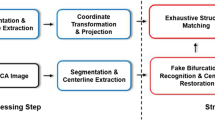Abstract
Purpose
Robust and accurate automated co-registration of the coronary arteries in 3D CTA and 2D X-ray angiography during percutaneous coronary interventions (PCI), in order to present a fused visualization.
Methods
A novel vesselness-based similarity measure was developed, that avoids an explicit segmentation of the X-ray image. A stochastic optimizer searches the optimal registration using the similarity measure.
Results
Both simulated data and clinical data were used to investigate the accuracy and capture range of the proposed method. The experiments show that the proposed method outperforms the iterative closest point method in terms of accuracy (average residual error of 0.42 mm vs. 1.44 mm) and capture range (average 71.1 mm/20.3° vs. 14.1 mm/5.2°).
Conclusion
The proposed method has proven to be accurate and the capture range is ample for usage in PCI. Especially the absence of an explicit segmentation of the interventionally acquired X-ray images considerably aids the robustness of the method.
Similar content being viewed by others
References
Gilhuijs KGA, van de Ven PJH, van Herk M (1996) Automatic three-dimensional inspection of patient setup in radiation therapy using portal images, simulator images, and computed tomography data. Med Phys 23: 389–399. doi:10.1118/1.597801
Murphy MJ (1997) An automatic six-degree-of-freedom image registration algorithm for image-guided frameless stereotaxic radiosurgery. Med Phys 24: 857–866. doi:10.1118/1.598005
Clippe S, Sarrut D, Malet C, Miguet S, Ginestet C, Carrie C (2003) Patient setup error measurement using 3-D intensity-based image registration techniques. Int J Radiat Oncol Biol Phys 56(1): 259–265. doi:10.1016/S0360-3016(03)00083-X
Markelj P, Tomaževič D, Pernuš F, Likar B (2008) Robust 3-D/2-D registration of CT and MR to X-ray images based on gradient reconstruction. Int J CARS 3: 477–483. doi:10.1007/s11548-008-0244-3
Lemieux L, Jagoe R, Fish DR, Kitchen ND, Thomas DGT (1994) A patient-to-computed-tomography image registration based on digitally reconstructed radiographs. Med Phys 21: 1749–1760. doi:10.1118/1.597276
Weese J, Penney GP, Desmedt P, Buzug TM, Hill DLG, Hawkes DJ (1997) Voxel-based 2-D/3-D registration of fluoroscopy images and CT scans for image-guided surgery. IEEE Trans Inf Technol Biomed 1(4): 284–293. doi:10.1109/4233.681173
Guéziec A, Kazanzides P, Williamson B, Taylor RH (1998) Anatomy-based registration of CT-scan and intraoperative X-ray images for guidance of a surgical robot. IEEE Trans Med Imaging 17(5): 715–728. doi:10.1109/42.736023
Turgeon GA, Lehmann G, Guiraudon G, Drangova M, Holdsworth D, Peters T (2005) 2D-3D registration of coronary angiograms for cardiac planning and guidance. Med Phys 32(12): 3737–3749. doi:10.1118/1.2123350
Breeuwer M et al (1998) The easi project-improving the effectiveness and quality of image-guided surgery. IEEE Trans Inf Technol Biomed 2(3): 156–168. doi:10.1109/4233.735780
Penney GP, Batchelor PG, Hill DLG, Hawkes DJ, Weese J (2001) Validation of a two- to three-dimensional registration algorithm for aligning preoperative CT images and intraoperative fluoroscopy images. Med Phys 28(6): 1024–1032. doi:10.1118/1.1373400
Kita Y, Wilson DL, Noble JA (1998) Real-time registration of 3D cerebral vessels to X-ray angiograms. In: MICCAI’98, pp 1125–1133
Hipwell JH, Penney GP, McLaughlin RA, Rhode K, Summers P, Cox TC, Byrne JV, Noble JA, Hawkes DJ (2003) Intensity-based 2-D-3-D registration of cerebral angiograms. IEEE Trans Med Imaging 22(11): 1417–1426. doi:10.1109/TMI.2003.819283
Florin C, Williams J, Khamene A, Paragios N (2005) Registration of 3D angiographic and X-ray images using sequential monte carlo sampling. Comput Vis Biomed Image Appl 3765: 427–436. doi:10.1007/11569541_43
Sundar H, Khamene A, Xu C, Sauer F, Davatzikos C (2006) A novel 2D-3D registration algorithm for aligning fluoroscopic images with pre-operative 3D images. In: SPIE Medical Imaging
Feldmar J, Ayache N, Betting F (1997) 3D–2D projective registration of free-form curves and surfaces. Comput Vis. Underst. 65: 403–424. doi:10.1006/cviu.1996.0499
Hamadeh A, Lavallée S, Cinquin P (1998) Automated 3-dimensional computed tomography and fluoroscopic image registration. Comput Aided Surg 3: 11–19. doi:10.3109/10929089809148123
Besl PJ, McKay ND (1992) A method for registration of 3-D shapes. IEEE Trans Pattern Anal Mach Intell 14(2): 239–256. doi:10.1109/34.121791
Fitzgibbon AW (2001) Robust registration of 2D and 3D point sets. In: Proceedings of the British machine vision conference BMVC, vol II, pp 411–420
Olabarriaga SD, Breeuwer M, Niessen WJ (2003) Minimum cost path algorithm for coronary artery central axis tracking in CT images. In: MICCAI’03, pp 687–694
Frangi AF, Niessen WJ, Vincken KL, Viergever MA (1998) Multiscale vessel enhancement filtering. In: MICCAI’98, pp 130–137
Press WH, Teukolsky SA, Vetterling WT, Flannery BP (1992) Numerical recipes in C: the art of scientific computing. Cambridge University Press, New York
Kennedy J, Eberhart RC (1995) Particle swarm optimization. In: Proceedings of the IEEE international conference on neural networks, vol 4, pp 1942–1948
Author information
Authors and Affiliations
Corresponding author
Rights and permissions
About this article
Cite this article
Ruijters, D., ter Haar Romeny, B.M. & Suetens, P. Vesselness-based 2D–3D registration of the coronary arteries. Int J CARS 4, 391–397 (2009). https://doi.org/10.1007/s11548-009-0316-z
Received:
Accepted:
Published:
Issue Date:
DOI: https://doi.org/10.1007/s11548-009-0316-z




